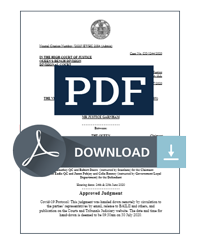The Use of Rap Lyrics in Criminal Trials
By Dr Abenaa Owusu-Bempah and Dr Felicity Gerry QC
As the New York State Senate debates Senate Bill S7527, to limit the admissibility of evidence of a defendant’s creative or artistic expression against such defendant in a criminal proceeding, this article sets out some of the issues we discussed in our Libertas Lecture / Webinar.
We raise concerns about the way rap lyrics are used in criminal trials in a way that does not appear to arise in relation to other genres. The issues outlined below are explored in more detail in A Owusu-Bempah, ‘The Irrelevance of Rap’ [2022] Criminal Law Review 130.
For decades, rap has been one of the most popular and profitable genres of music worldwide. While some subgenres of rap, such as ‘drill’, are characterised by first-person accounts of criminality, this should not be taken at face value. Rap relies heavily on hyperbole, figurative language and dark humour. It can operate as a form of social commentary, but much of the content is fictional and driven by commercial interests, as violence sells. For many, rapping is seen as a route to financial security, but it can also be cathartic, and generate a sense of belonging, particularly beneficial for those who come from marginalised communities.
As well as being a vibrant part of youth culture, rap music has become a target for police and prosecutors, with lyrics and music videos seemingly offering a means of linking suspects and defendants to crime. However, when rap is presented as evidence in court, the artistic conventions and social influences of the genre are often overlooked, and the use of (often irrelevant and unreliable) rap as evidence at criminal trials risks unduly prejudicing jurors against defendants. This is evident from the case law.
An analysis of over 30 reported judgments in the Court of Appeal of England and Wales (Criminal Division) in which rap lyrics or rap videos were used as evidence at a criminal trial or treated as an aggravating factor at sentencing shows that rap music is used almost exclusively as evidence against young Black men and boys (usually teenagers) who are accused of serious offences (namely weapons offences and violent offences, including homicide) in London and other urban areas. Often these are cases of ‘joint enterprise’ or alleged secondary liability, where rap is used to link defendants to each other and the crime, and often, or at the same time, as evidence of gang involvement, to place an offence in a gang context and to highlight association through music as a question of character, not culture. It is an extra burden for defence counsel to deal with such tropes, especially in highly charged murder or conspiracy to murder trials where some accused persons are associating on the periphery of a group through music.
This profile of cases, properly analysed, is concerning: Prosecutors may benefit from themes and aesthetics within rap music, by erroneously taking rap literally and using it to help build a case in which Black boys and men represent, or fit into, stereotypes of what a criminal looks or behaves like, including by branding them as ‘gang members’. The term ‘gang’ is vague and has been disproportionately applied to Black young people, including many who are not involved in crime, and in a way that does not correlate to the commission of serious youth violence.[1] This disproportionate application equips the term ‘gang’ with the ability to evoke images of Black criminality. Rap music can be used to amplify those images and further link Black men and boys to crime.
It is also concerning that, in their capacity as ‘gang experts’, police officers are often relied on to interpret and contextualise rap lyrics and videos. Being an expert on gangs does not, without more, make one an expert on rap. Unless the officer has studied the history, culture and conventions of the genre, has kept up to date with ever-changing slang, and/or is actively involved or immersed in rap culture, it would be more appropriate for the court to hear from musicians, industry insiders and social scientists, particularly scholars of hip-hop, rap and popular culture. We must also question the extent to which police can act impartially in this role. The organisation JUSTICE, has gone as far as to say that, in the context of explaining drill music, ‘the use of police officers as experts amounts to no more than the prosecution calling itself to give evidence.’[2]
In one homicide trial, in which Dr Felicity Gerry QC defended, one lyric relied on by the prosecution to impute bad character appeared in a search on Lyrics.com in 74,283 lyrics by 46 artists, and in 48 albums. Spelt another way, it appeared in 1,836 lyrics by 100 artists, and in 3 albums. These searches were undertaken by the defence, not the police officer who gave evidence. In that case, some music evidence was excluded by the trial judge but evidence of ‘nicknames’, hand signals and postcodes were admitted – suggesting at least the ‘ghettoization’ of young people in certain locations, even though Felicity’s client lived elsewhere. Her client and another were acquitted. A co-defendant, an emerging rap artist, was convicted.
Perhaps of most significance to criminal lawyers is the seemingly relaxed approach that the courts have taken to assessing the relevance and prejudicial effect of rap music as evidence of a crime. While lyrics that are directly connected to the crime charged could be relevant, in that they make it more likely that the author of the lyrics has some knowledge of (or connection to) the offence, rap was usually not presented in this way. Most often, generic and common-place lyrics about weapons and violence were used to help prove: state of mind (e.g. R v Soloman [2019] EWCA Crim 1356); criminal association and presence at the scene of a crime (e.g. R v Lewis [2014] EWCA Crim 48); propensity for violence or familiarity with firearms (e.g. R v O [2010] EWCA Crim 2985); and motive (e.g. R v Sode [2017] EWCA Crim 705). In Sode, a two-year-old music video in which the appellant was said to make gestures and remarks consistent with support for a gang (created when he was 14-years-old), was used as evidence of gang membership, which then went to the motive for an apparent gang rival attack. Likewise, it has been reported that at a first instance ‘joint enterprise’ trial, a rap video made as part of a community project was used as evidence against the young people who made it, which seems a remarkable approach by the prosecution. Importantly, the same approach is not taken when groups of rugby fans emulate Sir Tom Jones singing about killing Delilah.
The research by Dr Owusu-Bempah thus far shows that gang membership cannot be as easily inferred from rap music as the case law suggests. Assuming lyrics or videos are interpreted correctly, references to gangs is common in some rap subgenres, and non-gang affiliated young people participate in gang-themed music for a variety of reasons, including for fun, to appear more authentic, boost popularity, or as a ‘nod to’ their local audience. Also, Amnesty International found that identifying with a gang is ‘porous, fluid and often “for show”’,[3] making it difficult to draw a reliable inference of current affiliation from past indicators of support for a gang. That the age of the video in Sode was said not to ‘reduce its impact or diminish its relevance’ also demonstrates a lack of scrutiny of factors surrounding the creation of rap which affect relevance and probative value.
As for prejudicial effect, several empirical studies in the U.S. have found bias against rap music, rooted in racial stereotypes. For example, a 2018 study by Dunbar and Kubrin gave participants identical lyrics, with some being told it was rock, some country and some rap. The participants were ‘more likely to assume that a rapper is in a gang, has a criminal record, and is involved in criminal activity than are artists from other music genres, and this is based merely on the genre of the lyrics.’[4] These studies reveal the risk of rap music reinforcing biases, as well as the risk of rap being taken too literally. Yet, the racialised nature of rap evidence was not mentioned or addressed in any of the cases analysed, and the judgments tend to only go as far as acknowledging the potential for prejudicial effect, taking the view that admission was not ‘unduly prejudicial’, with little explanation as to why (e.g. R v Awoyemi [2016] EWCA Crim 668). Moreover, while directions to the jury are important (R v Rashid [2019] EWCA Crim 2018), they need not include information that will assist jurors to make sense of rap, such as the broader cultural context, artistic conventions, or the social influences within the rap music genre. This lack of context increases the risk of both improper reasoning and moral prejudice. In other words, discriminatory inferences from musical interests do not help juries to reach safe verdicts.
Fortunately, the increased use of rap as evidence has been accompanied by increasing pushback from academics, lawyers and NGOs, arguing for a far more rigorous approach to the admissibility and use of rap evidence. While the CPS is drafting new guidance on the use of drill music as evidence,[5] it is instructive to look to the proposed Bill in New York.[6] Under the proposal, evidence of a defendant’s creative or artistic expression would be inadmissible unless it is proven with clear and convincing evidence that it: is literal rather than figurative or fictional; has a strong factual nexus indicating that it refers to the specific facts of the crime alleged; is relevant to a fact in issue; and has distinct probative value not provided for by other admissible evidence. Importantly, any criteria for admission must not become a tick-box exercise to justify the admission of rap as evidence. Rather, we should strive to understand how approaches to ‘character’ ignore culture and to keep irrelevant, unreliable and/or highly prejudicial evidence out of the courtroom by not using rap lyrics in criminal trials.
[1] Amnesty International, Trapped in the Matrix (London: Amnesty International, 2018); See also P. Williams and B. Clarke, Dangerous Associations: Joint Enterprise, Gangs and Racism (London: Centre for Crime and Justice Studies, 2016).
[2] JUSTICE, ‘Tackling Racial Injustice: Children and the Youth Justice System’ (London: JUSTICE, 2021), para. 2.51.
[3] Amnesty International, Trapped in the Matrix (2018) p.9.
[4] A. Dunbar and C.E. Kubrin, ‘Imagining Violent Criminals: An Experimental Investigation of Music Stereotypes and Character Judgments’ (2018) 14(4) Journal of Experimental Criminology 507, 521.
[5] https://www.bbc.co.uk/news/uk-england-nottinghamshire-60070345
[6] https://www.nysenate.gov/legislation/bills/2021/s7527


